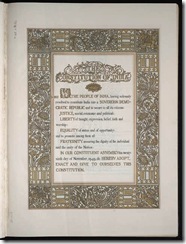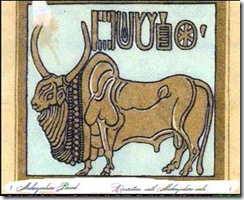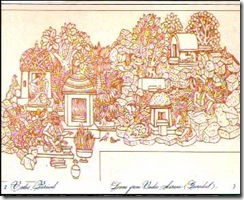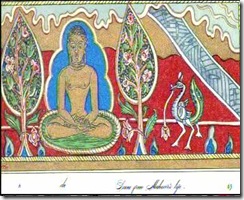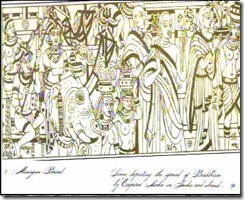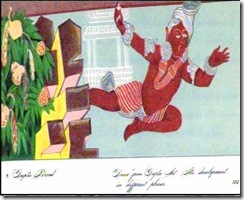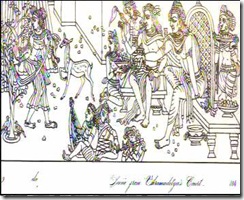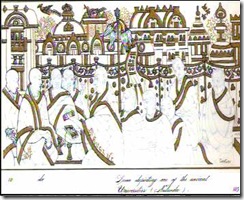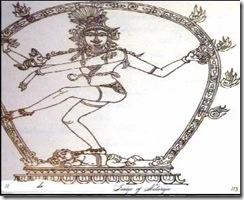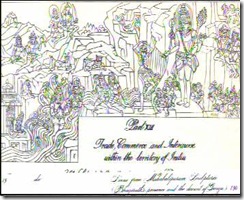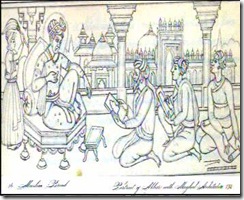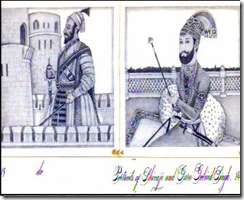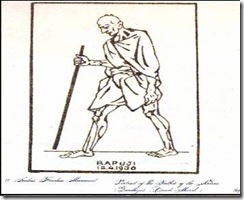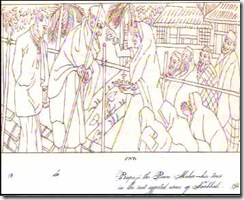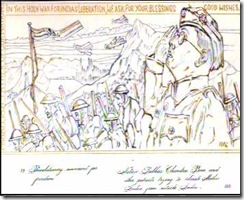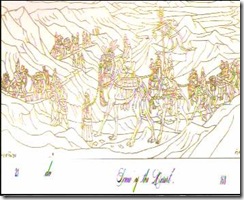I suggest that the original lithographed edition prepare by Nanda Lal Bose be reissued for use all over the nation. This edition contains images which adorn the Hall of Parliament of Bharat. These images show the roots of Bharata Ganatantra which should really constitute and complement the Preamble of the Constitution as approved by the People of India after deliberations in the Constituent Assembly. A 'Socialist' state is NOT a basic feature of the Constitution. Restoring the Preamble to its original wordings should be within the powers of Parliament to amend the book without invoking Keshavananda Bharati judgement restricting the powers of the Parliament to make amendments.
It is unfortunate that the lithographed version is available only in the Supreme Court Library and in Rashtrapati Bhavan. This should reach every citizen, all Bharatam Janam. This reissued Constitution documentj, fully illustrated with the paintings of Nanda Lal Bose and with photographs of the frieze panels in the Parliament building should be made essential reading in all schools.
It is time to dunk the secular nonsense, a word that has become redundant, meaningless in the context of Bharatiya traditions of Ganatantra for millennia.
When Indira Gandhi introduced the gloss 'secular', the pundits could not even figure out a Hindi translation for the word. After a dispute, the words chosen were a mouthful in Hindi: sampradaya nirapekshata.
This phrase was the compromise suggested by the Constitutional Expert Dr. LM Singhvi who was then advisor to Indira Gandhi who was struggling with a Hindi version which translated 'secular' as: dharma nirapekshata. Singhvi put in his papers with this rubbish translation stating that Bharata nation cannot be neutral as to dharma, the very foundation of the state was dharma. Hence, the compromise was worked out between two suggested translations: pantha nirapkshata or sapradaya nirapekshata. This means that the state can be neutral as to pantha of groups of people, what is referred to as matam in Tamil; or to samprdaya of groups of people denoting the traditions followed by groups of Bharatiya. This translation problem is indicative of the absurdity of the word 'secular' in the Preamble. The nation is secular, there is no need to describe this basic feature in the Preamble. As Ambedkar noted, there is no need to introduce the word 'socialist' since the Constitution does not have to endorse a particular political ideology. In this case, this ideology is already rejected in many states of the globe, exemplified by the collapse of the Socialist state of USSR, now Russia. The two words, 'secular' and 'socialist' are interpolations in the Preamble introduced by a Stalinist Nehruvian dictator, Indira Gandhi and no need to continue with the falsification of the objectives of the Founding Fathers of Bharat.
Kalyanaraman
See: http://bharatkalyan97.blogspot.in/2014/05/ec-on-modi-invoking-ram-how-about.html
http://kalyan97.wordpress.com/2007/10/16/1092/
http://kalyan98.wordpress.com/2008/01/02/rama-in-indian-constitution-court-observations/
http://bharatkalyan97.blogspot.in/2014/12/fraudulent-secularisation-of-indian.html
http://bharatkalyan97.blogspot.in/2013/09/secular-hypocrisy-over-imaginary.html
By Arvind Lavakare on
![3 roles secularists impose on BJP]()
http://bharatkalyan97.blogspot.in/2013/08/3-roles-secularists-impose-on-bjp.html
It is unfortunate that the lithographed version is available only in the Supreme Court Library and in Rashtrapati Bhavan. This should reach every citizen, all Bharatam Janam. This reissued Constitution documentj, fully illustrated with the paintings of Nanda Lal Bose and with photographs of the frieze panels in the Parliament building should be made essential reading in all schools.
It is time to dunk the secular nonsense, a word that has become redundant, meaningless in the context of Bharatiya traditions of Ganatantra for millennia.
When Indira Gandhi introduced the gloss 'secular', the pundits could not even figure out a Hindi translation for the word. After a dispute, the words chosen were a mouthful in Hindi: sampradaya nirapekshata.
This phrase was the compromise suggested by the Constitutional Expert Dr. LM Singhvi who was then advisor to Indira Gandhi who was struggling with a Hindi version which translated 'secular' as: dharma nirapekshata. Singhvi put in his papers with this rubbish translation stating that Bharata nation cannot be neutral as to dharma, the very foundation of the state was dharma. Hence, the compromise was worked out between two suggested translations: pantha nirapkshata or sapradaya nirapekshata. This means that the state can be neutral as to pantha of groups of people, what is referred to as matam in Tamil; or to samprdaya of groups of people denoting the traditions followed by groups of Bharatiya. This translation problem is indicative of the absurdity of the word 'secular' in the Preamble. The nation is secular, there is no need to describe this basic feature in the Preamble. As Ambedkar noted, there is no need to introduce the word 'socialist' since the Constitution does not have to endorse a particular political ideology. In this case, this ideology is already rejected in many states of the globe, exemplified by the collapse of the Socialist state of USSR, now Russia. The two words, 'secular' and 'socialist' are interpolations in the Preamble introduced by a Stalinist Nehruvian dictator, Indira Gandhi and no need to continue with the falsification of the objectives of the Founding Fathers of Bharat.
Kalyanaraman
See: http://bharatkalyan97.blogspot.in/2014/05/ec-on-modi-invoking-ram-how-about.html
Rama in Indian Constitution — Court observations
Rama Setu: Pictorial essay on rashtram, Shri Rama on Constitution of India
An illustration on a photolithographed edition of the Constitution of the Republic of India, in a painting by Nanda Lal Bose, shows Shri Rama as Rashtra Purush, national hero.
A set of paintings by Nanda Lal Bose which adorn the Constitution are appended. These paintings include the great national heroes starting with Vedic times, including Shri Rama, Shri Krishna, Mahavira, Buddha, Nataraja, Akbar, Shivaji, Gurugobind Singh, Lakshmi Bai, Tippu Sultan, Mahatma Gandhi, Netaji Subhas Chandra Bose, scenes depicting other historical episodes and scenes from the Himalaya, from the desert and from the Ocean. The scenes adorn each section of the Constitution. The Part on Fundamental Rights is adorned by Shri Rama and the Part on Directive Principles of State Policy is adorned by Shri Krishna.
One of 1000 photolithographed reproductions made in 1955 of the Constitution of the Republic of India, ratified in 1949, two years after India became independent of Britain:
The Constitution of India.
Calligraphy by Prem Behari Narain Raizda, illuminated by Nand Lal Bose.
Dehra Dun, India: Survey of India Offices, 1955.
Rare Book Collection,
Law Library (70.1)
Calligraphy by Prem Behari Narain Raizda, illuminated by Nand Lal Bose.
Dehra Dun, India: Survey of India Offices, 1955.
Rare Book Collection,
Law Library (70.1)
Law Library Reading Room, Library of Congress, Washington D.C.
Constitution of India, 1949
This book is one of 1000 photolithographed reproductions made in 1955 of the Constitution of the Republic of India, ratified in 1949, two years after India became independent of Britain. Concern for the rights of citizens is the basic principle established in the constitution, which sought to assimilate the various linguistic regions and religious groups of India into a cohesive nation. The opening page, shown, contains language echoing that of the Constitution of the United States. Borders, illuminated with real gold in the original, surround the text and illustrations, in Indian art styles of various times.
This entry was posted on Thursday, September 20th, 2007 at 2:46 am and is filed under Civilization. You can follow any responses to this entry through the RSS 2.0 feed. You can leave a response, or trackback from your own site. Edit this entry.
http://kalyan98.wordpress.com/2008/01/02/rama-in-indian-constitution-court-observations/
What I heard is all Modi said is let lotus bloom in land of Ram, which is Ayodhya...
Fraudulent Secularisation of Indian Constitution;Insertion of word ‘Secular’ in Indian Consitution on the Sly - Ram Kumar Ohri, IPS (Retd)
Fraudulent Secularisation of Indian Constitution
Insertion of word ‘Secular’ in Indian Consitution on the Sly
- Ram Kumar Ohri, IPS (Retd)
It is astounding that Minister for External Affairs, Sushma Swaraj, is being pilloried by our partisan media and secular chatterati largely consisting of ignorant WOGS (i.e., West Oriented Gentlemen) and their fellow travellers. She has been targeted for suggesting that the Bhagwad Gita should be declared as Rashtriya Granth, or the national book of India. Prima facie there is nothing wrong in the suggestion made by the euridite lady. After all, Gita is the soul of the millennia old Indian civilization. It is the song celestial sung by Sri Krishna to awaken and invigorate a faltering Arjuna in the battlefield at Kurukshetra.
It is being argued by some inadequately-read self-styled intellectuals and media mandarins that since our Constitutioin describes India is a ’secular’ nation, a religious book of Hindus, like Bhagwad Gita, cannot be designated as our national book. Ah, secularism ! But who forced the bogey called secularism into our Constitution ?
Time has come to inform the comatose Hindu leaders and our slumbering masses about the forgotten truth that the word, ‘secular’, did not exist in the original text of the Indian Constitution when it was adopted in November, 1950. The founding fathers did not, repeat did not, describe India as a secular nation despite compulsive obsession of Pandit Nehru with this dogmatic western cult which is frequently pitted against ‘ dharma’. Equally important is for us to remember that there was no mention of the word ‘socialist’ in the original text of Indian Constitution. A massive deception practiced by the unconstitutional political rulers in 1977 was that the word ‘secular’ was foisted by late Indira Gandhi on the gullible Indian mass on the sly during the dark era of Emergency.
Why was it done during the years of Emergency when all rights of the citizens had been suspended and press too, was totally gagged ? No one knows, no one can explain. The questionable word was forced into the Preamble in a clumsy bid to consolidate the minority votebank in 1977 by the then Prime Minister and her kitchen cabinet. She added two mischievous words into the Preamble of the Constitution thereby converting India into a ‘socialist and secular’ Republic. Perpetrated during the Emergency it was a fraud of monumental proportions.
This unwarranted intrustion into the Constitution was made through the 42nd amendment in 1977 when democracy was dead, voice of the people was muzzled and fundamental rights had been suspended. The Forty-second Amendment of the Constitution of India, officially known as The Constitution (Forty-second Amendment) Act, 1976, was enacted during the Emergency by the government headed by Indira Gandhi. Most provisions of the amendment came into effect on 3 January 1977, while some other changes were enforced with effect from February 1, 1977.1
As highlighted on the website of Wikipedia, the “42nd amendment is regarded as the most controversial constitutional amendment in Indian history. It attempted to reduce the power of the Supreme Court and High Courts to pronounce upon the constitutional validity of laws. It laid down the Fundamental Duties of Indian citizens to the nation. This amendment brought about the most widespread changes to the Constitution in its history, and is sometimes called a "mini-Constitution" or the ‘Constitution of Indira’.2 Almost all parts of the Constitution, including the Preamble and the amending clause, were changed by the 42nd Amendment, and some new articles and sections were inserted. The amendment's fifty-nine clauses stripped the Supreme Court of many of its powers. Additionally, the amendments curtailed the democratic rights in the country, and gave sweeping powers to the then Prime Minister.
Among other things, the controversial amendment gave to the Parliament unrestrained power to amend any parts of the Constitution, without judicial review. It transferred more power from the state governments to the central government, eroding India's federal structure. The 42nd Amendment also amended the Preamble and changed the description of India from "sovereigndemocratic republic" to a “sovereign socialist secular republic” which was never the intention of the founding fathers when they drafted and passed the Constitution.
The Emergency era had been widely unpopular. But the most controversial misconduct was the clampdown on civil liberties. The Janata Party which had promised to "restore the Constitution to its original condition as it was before the Emergency", won the 1977 general elections. They then brought about the 43rd and 44th amendments in 1977 and 1978 respectively, to restore the pre-1976 position to some extent. However, the Janata Party was unable to achieve its full objective because the government could not last long enough due to internal squabbles between party’s leadership.
On 31 July, 1980, in its judgement on Minerva Mills v. Union of India, the Supreme Court declared two provisions of the 42nd Amendment which prevented any constitutional amendment from being "called in question in any Court on any ground", and accord precedence to the Directive Principles of State Policy over the Fundamental Rights respectively, were declared unconstitutional. That historic judgement of the Supreme Court was tantamount to legal censure of the conduct of the government led by late Indira Gandhi in turning India into a secular State.
It needs to be understood that in their infinite wisdom the founding fathers did not add the word ‘secular’, nor the word socialist in the Preamble of Indian Constitution. They knew that a Hindu-majority nation, supremely believing in tolerance, can never become a theocracy. History is a witness to the fact that our forefathers had magnanimously given asylum to the Parsis as well as the Jews when they were forced to run away after being persecuted in their own homelands. The founding fathers knew very well that according to our holy scriptures and millennia- old historical tradition Hinduism can never become a narrow sectarian faith.
When the Parsis and the Jews were being hounded out from their native lands, it was the Hindu rulers who gave them shelter - and that too, without imposing any pre-conditions. That is why the founding fathers of the Constitution did not declare India a secular State in the year 1950. On the contrary in spite of Pandit Nehru, they boldly affirmed the Hindu identity of India by incorporating 20 paintings from our ancient history to embellish the hand-written first copy of the Indian Constitution.
The twenty paintings displayed in the Constitution constitute clear reiteration of India’s ancient heritage and its Hindu identity by the founding fathers. First and foremost, the paintings depicted Lanka Vijay by Shri Ram, Gita Updesh to Arjuna at Kurukshetra by Karamyogi Krishna, Ganga Anayan by Bhagirath and portraits of Raja Vikramaditya, Gautam Buddha, Mahavira, Chhatrapati Shivaji, Guru Gobind Singh and Rani Lakshmibai of Jhansi. There is a painting of the Nalanda University, too. In addition paintings of Mahatma Gandhi and Netaji Subhash Chandra Bose, the two 20th century icons of India’s freedom movement, are also there.3
There is also one painting each of Moghul king Akbar and Tipu Sultan of Mysore in the Constituton. But these two paintings could not be construed by any means as the Constiuent Assembly’s endeavour to erase the Hindu identity of India. The clumsy attempt to belittle the Hindu identity of India, presently writ large all over the original Indian Constitution, is a later day development carried out on the sly during the notorious years of Emergency by adding the word “secular” to the Preamble. Prima facie there are reasons to believe that a nefarious thought was occupying the mind of by the ruling sham-secularist gang and pro-left academia to conceal the truth from the future generations of India. At one time, it was a hush-hush rumour in the gossip bazaar of Lutyen’s New Delhi that an attempt was being made to remove these 20 important paintings from the Constitution. But that was not done, could not be done. Perhaps the enormity of the proposed insult to the Indian Constitution and the fear of Hindu backlash did not allow the leftist seculars to venture ahead on that path.
Today’s youngsters do not know that the calligraphy of the hand-written copy of Indian Constitution was done by Prem Behari Narain Raina and it was embellished by Nandlal Bose and some other artists. The hand-written Constitution was photo-lithographed at the Survey of India Office. Apparently, most journalists and tele-media analysts, too are are unaware of these facts.
The aforesaid 20 paintings can be seen at the website Slide Share:http://www.slideshare.net/slideshow/embed_code/30459044.
It is time that the present and future generations of India are made aware of the fact that the founding fathers never wanted India to be declared a ‘secular’ State. Nor did they consider it necessary to make India a ‘socialist’ State. This important fact stands conclusively proved by the depiction of 20 paintings of the glorious Hindu heritage and landmark ethos of our country permanently embedded in the original hand-written copy of the Indian Constitution. It was done ostensibly for the benefit of the posterity.
Time has come for Hindu nationalists to confront the morbid rants of the secularist ignoramuses by repetitively asserting that India was meant to be a secular State by the founding fathers ! In wisdom and strategic foresight the founding fathers of the Indian Constitution were much more far-sighted than Indira Gandhi and her atheist father, Pandit Nehru.
Logically the above mentioned amendments to the Constitution should have been rescinded immediately after the Emergency was over. But the governments led by Morarji Desai and Chaudhry Charan Singh could not complete the task due to internecine warfare in the Janta Dal. Now with the fresh winds of reawakening of national pride blowing across India, time has come to expunge the questionable words secular and socialist from the Preamble of the Indian Constitution. Most European countries have turned their backs on the suicidal cult of multi-culturalism which threatens to erase the Christian identity of Europe.
************
References:
1. Source: Wikipedia, the international encyclopedia.
2. Ibid.
3. Source : The World Digital Library and the website of Indian Kanoon.
Secular hypocrisy over an imaginary Hindutva agenda
By Arvind Lavakare onEven before the Narendra Modi team has uttered a word about its national plan if it forms the Union Government in 2014, chronic anti-BJP interests, including some from the media, are using every chance to sound alarm bells about the ‘Hindutva agenda’ of a Ram Temple at Ayodhya, abrogation of Article 370 and introduction of a Uniform Civil Code. Some bright ones add the ban on cow slaughter as well.
That this agenda constitutes an anti-national phenomenon is nonsense, as we shall see, but what is laughable is what set off the alarm.
It began with Modi’s interview to Reuters in which he agreed with the interviewer that he was a Hindu nationalist by virtue of the fact that he was a Hindu and a nationalist, and therefore a Hindu nationalist.
In screaming at this view, journalists forgot that during the 2008 nuclear debate in the Lok Sabha, Omar Abdullah had begun his speech by saying, “I am a Muslim and I am an Indian. I see no difference between the two.”(Outlook magazine, of July 22, 2008) Abdullah had been lauded for that comment but Modi is to be lambasted now for an identical remark. Does religion make a difference for the fanatical BJP-haters?
Mediamen also seized that Reuters interview for Modi’s comment that he did of course feel hurt bythe Godhra riots, just as a man in a car would be hurt even if a pulpy came under his car’s wheels. “See, how he comparers Muslims to puppies”, they say. Bizarre radiologists and linguists they who can read the mind and read a puppy for a Muslim and Muslims for puppies.
Another spark lit for the Modi and Hindu-haters is Amit Shah’s, Modi’s lieutenant, visit to Ayodhya soon after being deputed to handle the BJP campaign in Uttar Pradesh. “Why did he have to visit Ayodhya? What was his sinister motive?” That questioning was as pitiable and naïve as someone asking why the most ardent wish of a Muslim visiting Mumbai is to pay homage in the Haji Ali dargah. Further, Shah did not promise a Ram Temple on that visit of his. The TV footage will show that all he did was to pray that the grand temple would be built at the site. What is abominable about praying for a wish to come true?
The trouble is that journalists are known to find little time to read beyond what their fraternity writes and speaks on TV. Hence they are unaware that the demand for a Ram Temple has essentially been a demand to remove what is today a 423-year-old encroachment on someone else’s property. The encroachment was disclosed by a court verdict of 1886.
It was a civil appeal (number 27 of 1885) by one Mahant Raghubardas and the defendant respondents were the Secretary of State for India and one Mohammed Azghar. In his judgenment delivered on March 18, 1886, the District Judge, Colonel Chamier recorded as follows: “I visited the land in this dispute yesterday in the presence of all parties. I found that the masjid built by Emperor Babar stands on the border of the town of Ayodhya, that is to say, to the west and south. It is clear of habitations. It is most unfortunate that a masjid should have been built on land specially held sacred by the Hindus, but as that event occurred 356 years ago, it is too late now to remedy the grievance. All that can be done is to maintain the parties in status quo. In such a case, as the present one, any innovation could cause more harm and derangement of order than benefit.”
Unbelievably, that finding of 1886 by a British judge was confirmed by a three-judge bench of the Lucknow High Court on September 30, 2010, but it decided that the site concerned be shared by the contesting parties. In short, the elephant has gone and only the tail remains. The Ram Temple at Ayodhya is now a certainty but the judicial process now remains in the Supreme Court. Hence, the Ram Temple issue will now be left to the Apex Court or to negotiations over the table. The BJP, under Modi or anyone else, is not foolhardy to resolve it over pitched battles. The BJP-haters should understand that.
About Article 370, the BJP has long understood that it is neither an issue to be fought in the courts or on the streets. That Article can be abandoned only with the permission of the J&K Government in power and that permission itself is ruled out as long as the Kashmir Valley holds sway over the J&K. But there’s every reason to raise it in the public domain for people in the rest of our country to understand that it is the continuance of that Article which has prevented that State from being truly and emotionally integrated with the rest of India. It is that continuance which has made the State’s economic existence, by its own confession, entirely dependent on doles from the Union Government whose revenues comes entirely from the taxes paid by millions of non-J&K parts of the nation. Article 370 therefore remains a “national” issue, not a Hindu one.
It would therefore be in the national interest if the BJP under Modi exhorts the nation to secure such modifications in the J&K State Constitution as will enable Article 370 to bring the J&K State and the rest of the nation a giant step closer to each other. For instance, the provisions of Central Bureau of Intelligence and Investigation should be made applicable to J&K State. Also, all the privileges — which include contesting and voting for the State Assembly and eligibility to Government scholarships — which are presently given only to the category called ‘Permanent Residents’ in J&K should be accorded to all Indian citizens living in that State. And why should the life term of the J&K State Assembly be of six years while it is five years in the rest of India?
Similarly, the introduction of a Uniform Civil Code for the entire country is not an item of inclusion exclusively in any Hindu agenda. It is something which all nation-loving Indians must try to bring about insofar as it brings equitable treatment to all women in all our communities. The Supreme Court of India has, at least three times in the past, harped on the dire need for the nation to have such a uniformity in civil laws. Go to Google and you’ll get the details, including that of a Justice Kuldip Singh who, in just one judgement, mentioned the need for it as many as 20 times.
Lastly, there’s that topic of a ban on cow slaughter which is resented by many non-Hindus. For ‘foodies’, the subject is a no-no and no Hindu from the BJP or any other political party can quarrel with that. But for those who think much beyond the dining table, the following two excerpts from a comprehensive speech made by Pandit Thakur Das Bhargava on November 24, 1948 in the Constituent Assembly debates (which, remember, framed our nation’s Constitution) should give food for thought:
“…in China, cow-slaughter is a crime. It is banned in Afghanistan as well. A year ago, a similar law was passed in Burma…
“Even during the Muslim rule, Babar, Humayun, Akbar, Jahangir and even in the reign of Aurangzeb, cow slaughter was not practised in India; not because Muslims regarded it to be bad but because, from the economic point of view, it was unprofitable.”
Yes, the belittling and battering of the so-called ‘Hindutva’ agenda is simply a lot of nonsense.
http://www.niticentral.com/2013/09/26/secular-hypocrisy-over-an-imaginary-hindutva-agenda-ii-137933.html3 roles secularists impose on BJP
By Arvind Lavakare on

Detained at Jammu airport on August 10, 2013, and prevented from proceeding to Kishtwar District of Jammu & Kashmir State in order to personally ascertain the facts of the recent communal violence there, Arun Jaitley, Leader of Opposition in the Rajya Sabha, has been reported as saying, inter alia, “This is the biggest example of failure of secularism in this country” (Free Press Journal, August 11, 2013)
Jaitley must have been truly stunned and upset by the detention ordered by Omar Abdullah, Jammu & Kashmir’s Chief Minister. This must be the only reason why the BJP’s legal eagle must have momentarily forgotten a fact of our Constitutional history. That fact is that J&K is the only State in our country which is not officially pronounced officially as “secular”. Yes the Preamble of the State’s own, independent and exclusive Constitution, (promulgated in November 1956), does not – repeat, does not — proclaim the State to be “Secular”! Hence, Jaitley erred in thinking that the Indian soil on which he was detained was ‘secular’. QED. Sadly, this Constitutional truth is almost unknown to our politicians, big and small, especially the BJP who should have sworn by it all along.
The reason for this shocking aberration is that the J&K State Government refused to accept that part of Indira Gandhi Government’s 42nd Constitutional Amendment Act of 1976, which changed the constitutional Preamble characterisation of India from a “sovereign democratic republic” into “sovereign socialist secular democratic republic” with the addition of the words “socialist secular” in our Constitution’s Preamble, was notmade applicable to J&K. Article 370 of our Constitution was playing its role because it is that Article which permits the J&K Government the right to refuse the applicability of any law of the Indian Parliament that does not relate to an issue of defence, external affairs and communications. It is this Article which the BJP has wanted to abolish for decades but which the rest of the country has refused to permit. Why? Because the non-BJP India believes that abrogation of Article 370 is a Hindu agenda. Can anything be more stupid than that belief?
As an aside, let it be recorded here that because the 42nd Constitutional Amendment had left the word “secular” undefined, thereby leaving a lot of ambiguity around. Morarji Desai’s Janata Party Government had wanted to correct the situation. Hence, in its 44th Constitutional Bill of 1977, it inserted a clause defining “secular” as sarva dharma samabhav (equal respect for all religions). While the change was passed in theLok Sabha where the newly elected Janata Party members had the required majority, the definition was rejected in the Rajya Sabha where the Congress members enjoyed a six-year term. That is why the word “secular” is such a plaything today for pseudo-secularists and those who clamour for reservations of various kinds for religious communities. Tragically, that episode in our Constitutional history seems also unknown to our politicians.
By the way, the 42nd Constitutional Amendment of India also changed the Preamble’s purpose of securing for its citizens a “unity of the nation” as part of the clause explaining Fraternity therein into “unity and integrity of the nation”. But the “integrity” part was not made applicable to J&K Government. What, pray, did J&K and the Government of India intend to signal with that dangerous exclusion? Recent events in Kishtwar, like innumerable others in J&K are the fallout of that signal from long ago.
Apart from Article 370, there are two other issues which pseudo-secular India thinks constitute the ‘Hindutva agenda’ on which the BJP should play the proverbial three monkeys. One is the building of the Ram Temple at Ayodhya in Uttar Pradesh, the other is the issue is of enacting a Uniform Civil Code as directed by Article 44 of the Constitution of India.
From the 1980s, till the demolition of the Babri Masjid by fanatics in 1992, the BJP had publicly proclaimed the building of a Ram temple at Ayodhya as their passion even as a court case on the issue lay almost moribund. Towards that end, archaeological, revenue and historical records were used by the BJP to persuade the Muslim community to give up their claim to the masjid. Even an offer was made to shift the masjid, brick by brick, to a nearby suitable site. But to no avail. And then happened the tragic demolition. A mini Ganges has flown under the bridge after the Division Bench of the Allahabad High Court gave its majority judgement a couple of years ago, accepting the BJP’s contention that the Ram Janmabhoomi was in fact the birthplace of the revered Hindu god Ram, and that a Ram temple had in fact stood at that site before it was demolished by Mughul invaders. Since that verdict is under appeal in the Supreme Court, how and why can the BJP project it as a part of the Hindu agenda to be agitated for in any election? A playback of the relevant video clip will reveal that what Amit Shah did on his first visit to Ayodhya two months ago was simply pray for a grand Ram temple to be built at the site. He did not threaten an agitation over it. It is not understandable how a Ram temple can be brought into existence on the so-called Hindutva agenda. But how will pseudo-secularists of various political hues ever understand that?
Last, there is the third monkey that the pseudo-secularists want the BJP to be – avoid seeing, hearing or talking about the Uniform Civil Code. Although it is a mandate of the founding fathers of our Constitution, it is not enforceable by our courts. However, the Supreme Court has upheld the need for such a Code several times in the past.
In 1995, the Supreme Court of India was asked to review four cases where Hindu men had converted to Islam in order to marry a second wife (Sarala Mudgal vs Union of India, AIR 1995 SC 153). In each case, the first marriage had been solemnised under the Hindu Marriage Act of 1954. Presiding over the matter, Justice Kuldip Singh’s ruling was quite fascinating in a number of respects.
First, he pointed out, “In India there has never been a matrimonial law of general application. Apart from statute law a marriage was governed by the personal law of the parties.” Second, he mentioned “a marriage celebrated under a particular personal law cannot be dissolved by the application of another personal law to which one of the spouses converts and the other refuses to do so.” He pointed out that “since monogamy is the law for Hindus and the Muslim law permits as many as four wives in India, errant Hindu husband embraces Islam to circumvent the provisions of the Hindu law and to escape from penal consequences.”
In his rather lengthy ruling, he touched on the importance of a Uniform Civil Code for India twenty times. Yes, 20 times! Singh was clear in his call for a Uniform Civil Code when he remarked, “Successive Governments till date have been wholly remiss in their duty of implementing the Constitutional mandate under Article 44.”
In 2003, the Supreme Court, in John Vallamattam vs Union of India, AIR 2003 SC 2902, under Chief JusticeV N Khare made a similar call in his remark “We would like to state that Article 44 provides that the State shall endeavor to secure for all citizens a uniform civil code throughout the territory of India. It is a matter of great regret that Article 44 of the Constitution has not been given effect to. Parliament is still to step in for framing a common civil code in the country.
So, why are bleeding-heart pseudo-secularists bashing the BJP for its demand for a Uniform Civil Code, for abrogation of Article 370 and for merely praying for a grand Ram temple in Ayodhya? The concerned monkeys must answer.
http://www.niticentral.com/2013/08/13/3-roles-secularists-impose-on-bjp-117910.htmlhttp://bharatkalyan97.blogspot.in/2013/08/3-roles-secularists-impose-on-bjp.html
